To overcome this challenge, we dug into current customer service trends by surveying 1,537 service leaders globally to understand how they put customers first.
In this article:
- Why Companies Should Listen to Their Customers
- What Do Today’s Buyers Want?
- How Can Your Business Adapt?
- Examples of Companies That Listen to Customers
Why Companies Should Listen to Their Customers
Listening to customers is essential because customers have the power to make or break a company. Not giving an ear to customers is one reason sour customer stories exist with companies like ComCast, Snapchat, and Amazon.
A strong customer focus is critical for growth, as today’s consumers hold unprecedented power in the buying process.
According to our previous report, 76.2% of customer service professionals agree customers are more informed than they used to be. This uptick in consumer behavior is closely linked to the rise and popularity of social media. In fact, our latest consumer Trends Report shows 1 in 4 consumers prefer to discover new products through social media over any other channel.
Social media platforms provide extensive reach, and a single instance of feedback on products and services can impact the purchasing decisions of others. That’s why it’s unsurprising that 9% of our surveyed service leaders said social media is an effective customer service channel. By being on social media, these leaders can interface with customers where they hang out.
To sum up, customers today are smarter, have higher expectations, and — good or bad — are likely to share their experiences on social media or review sites where the feedback is permanent.
This power shift can be daunting if your product or service isn’t up to par. However, if you have a strong product and offer a great customer experience, this is an opportunity to leverage the customers’ power, turn them into advocates, and fuel your growth.
What Do Today’s Buyers Want?
Before AI disrupted the tech landscape, the empowered consumer was interested in:
- Product information (demos/explainers).
- Reviews and social proof from users like them.
- Discounts and deals.
- Customer examples and case studies.
- Educational content, strategy, and best practices.
Thankfully, I’ve seen most companies adapt and make most of these available. However, companies must now prepare to meet the current and future needs of today’s buyers. When we asked our service leaders to chime in on this, two core themes emerged. Let’s take a look.
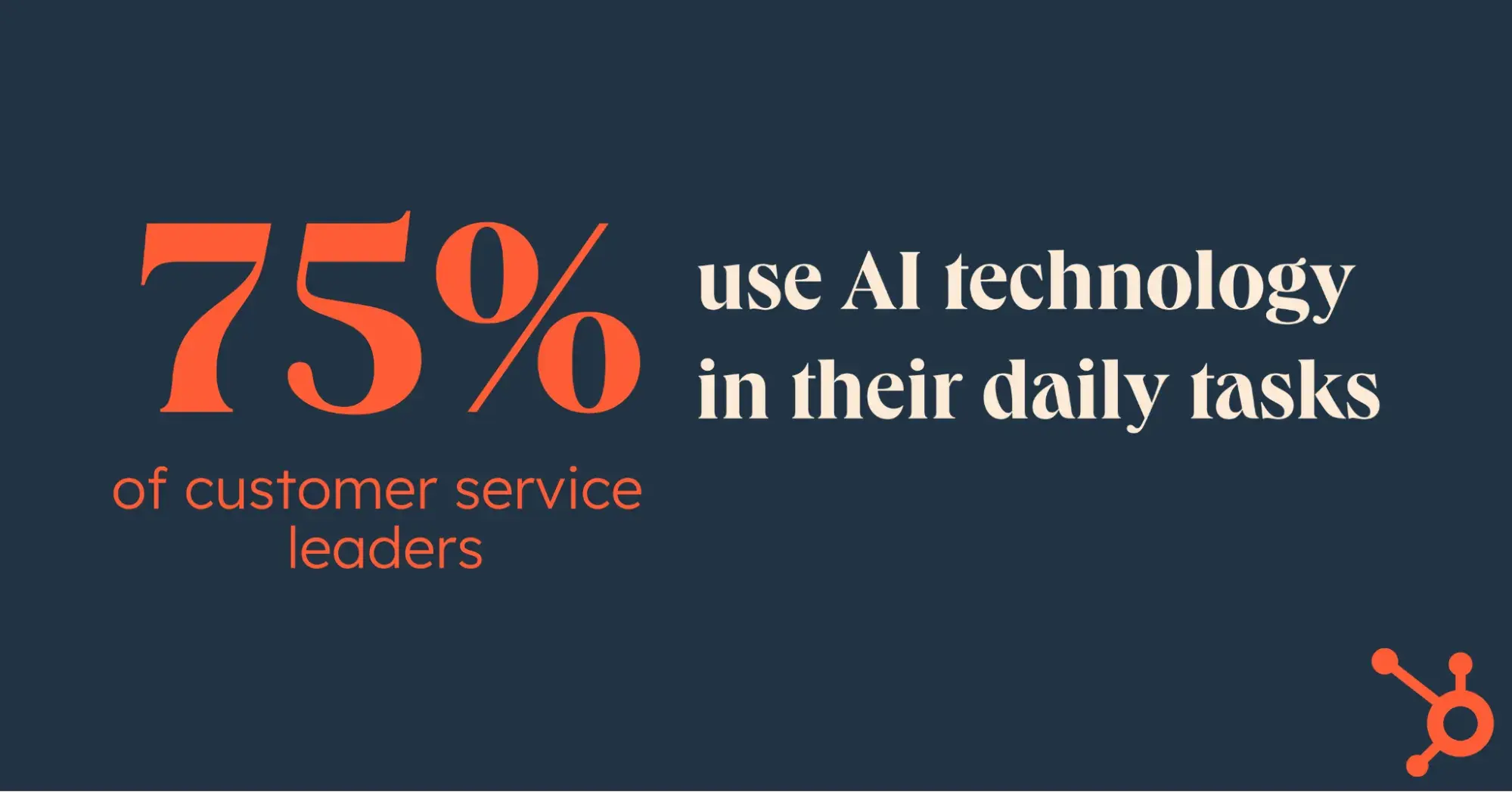
Major Theme: More service leaders need to adopt AI.
Many people questioned the emergence of AI in 2023. But by 2024, AI is still going strong. While many still wonder if AI is a fad, others have invested in it.
Our research shows AI is not fizzling away, as over 75% of customer service leaders use AI technology in their daily tasks. These leaders use AI because it’s versatile, efficient, and doesn’t have a hefty impact on their budget. Besides personalizing customer interactions and surpassing KPIs like retention and customer lifetime value, here are some benefits service leaders attribute to AI:
- Improved customer service response times (92%).
- Positively impacted CSAT (86%).
- More straightforward response to service requests (83%).
- Helped to scale operations (86%).
- Better for scaling operations than hiring more reps (65%).
These benefits make over 80% of CRM leaders optimistic that customer service professionals will use AI by 2025.
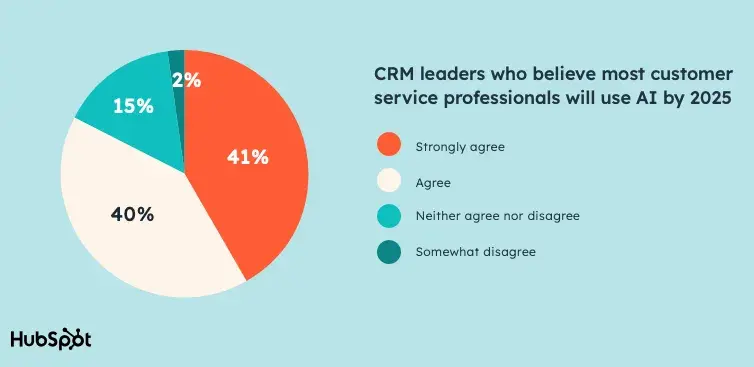
According to these service leaders, AI is impactful because 59% said it decreased their customer service spending, while only 31% recorded an increase.
I believe this spending cut is what’s fueling 71% of CRM leaders to increase their AI investment in 2025. With such investment, 77% of CRM leaders believe AI will handle most ticket resolutions by 2025 and help address churn at its root — and sometimes preventing it altogether.
As a service professional, you can get the most from your investment by choosing a robust customer service software with AI at its core. HubSpot provides such AI technology in its Service Hub and gives you end-to-end customer journey visibility without driving up external costs.
Kaplan is one of several brands that have experienced the benefits of HubSpot’s Service Hub. With the AI features in Service Hub, Kaplan streamlined customer interactions and improved both service efficiency and customer satisfaction.
The outcome?
- 25-30% of customers self-serving through the AI chat.
- 30% decrease in average ticket response time.
- 63% improvement in retention rate of customer service staff year-on-year.
Major theme: More service leaders need CRM adoption to unify teams.
Learnings from the customer service leaders we surveyed show they face challenges with data silos, which leads to fragmented communication among sales, marketing, and CS teams. Both issues can cause increased support tickets, reduced CSAT — and worse: customer churn.
A robust customer relationship management (CRM) tool will fix these problems and unify all teams. With a CRM, service leaders have more visibility of their customer’s journey. Yet, only 68% of service leaders report using CRM software in their daily operations. This lack of adoption creates inefficiencies that can undermine team effectiveness.
One negative effect of not using a CRM is tool sprawl — where multiple disconnected tools are used across departments. This leads to constant switching between systems, wasting valuable time, and delaying ticket resolutions. A striking 74% of service leaders say tool sprawl slows down their teams, making it harder to respond to customer issues efficiently.
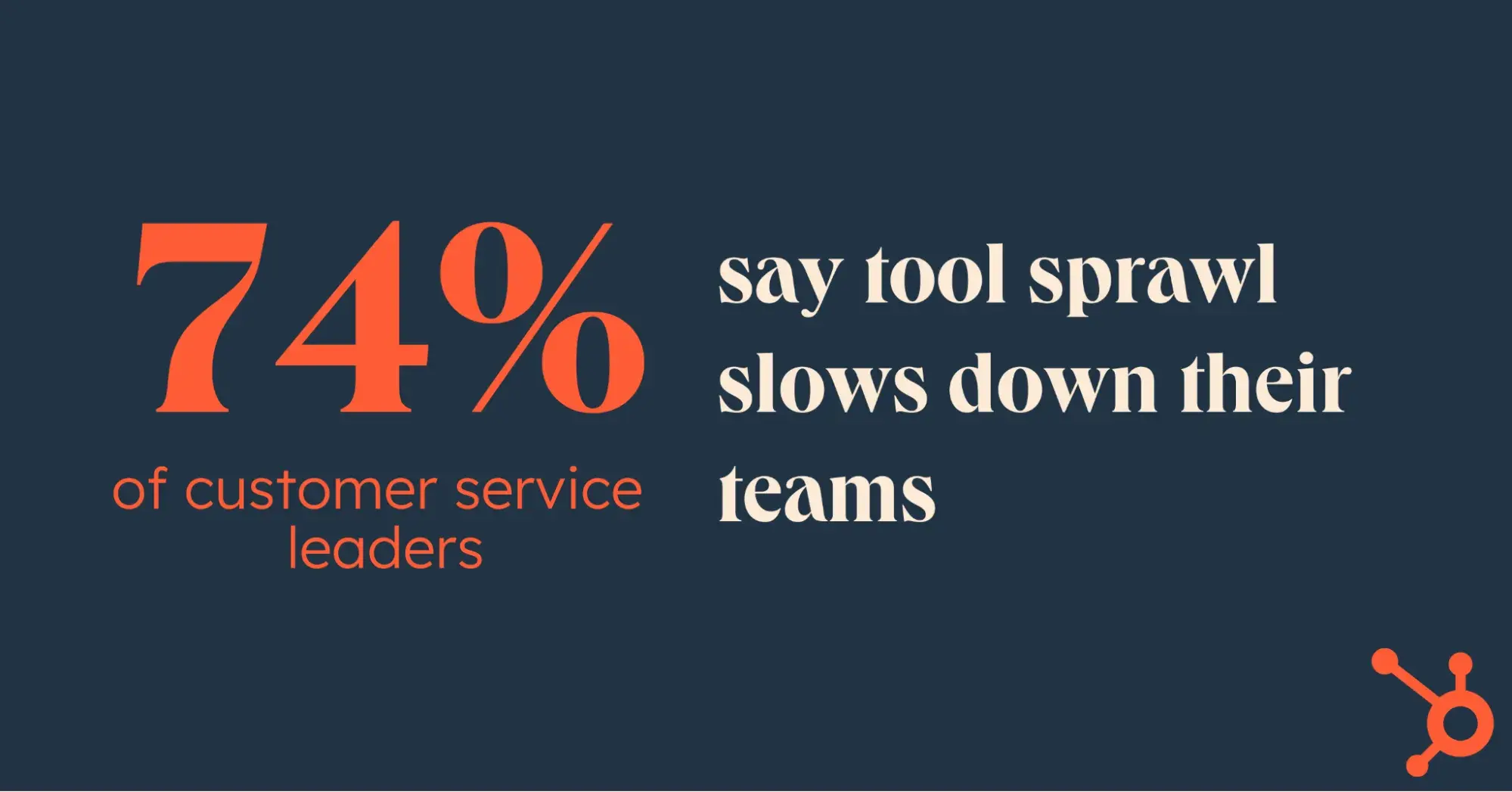
Combating these issues is easy. By using a unified CRM platform, service teams can eliminate silos, streamline processes, communicate faster, and enhance the customers’ experience. According to service leaders, CRM adoption is also vital for tackling tool sprawl in 2024 and beyond as they look to boost efficiency and improve customer satisfaction.
How Can Your Business Adapt?
The easiest way to become more customer-centric is to open up and formalize listening channels. How do your customers want to communicate with you? Are you recording that data systematically? Are you asking the right questions?
Live Chat
Live chat is just one channel to capture customer insights — but it‘s popular for a reason and can help increase the amount of feedback you’re getting tremendously. It also delivers customers‘ answers in real time. It’s hard to underestimate how happy a quick answer can make a customer.
Live chat is even better with AI. Service leaders who use the HubSpot AI chatbot said they save an average of 2 hours and 20 minutes daily. This time saving is an enormous opportunity for many companies like Agicap, which saves 750 hours weekly and increases deal velocity by 20% with HubSpot's AI. One way Agicap achieves this is by leveraging our free AI Chatbot AI Builder, which not only provides customer support but qualifies leads and books meetings.
Customer demand is aligned with the AI movement, as an AI Chatbot ranks as the most effective and most preferred customer service channel. Service leaders also say their CSAT levels rise with the presence of AI-powered customer support.
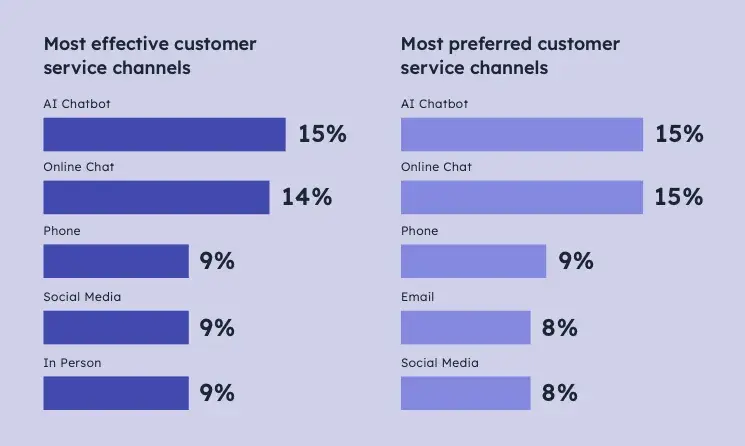
Help Desk
Opening your service team up to more incoming customer questions can be tricky. There is always a chance your team will get overwhelmed quickly, especially if you‘re growing. As such, it’s important to design the customer experience you want – one that's great for your customers but also allows you to scale your team effectively.
Building a help desk will allow you to do this. A help desk combines different customer channels with a shared inbox, tickets, automation, and reporting to deliver the ideal customer experience. From our conversations with customers, over 85% of companies with a help desk system said it makes them more productive.
Self-Service Solutions
The best way to help savvy customers is to help them help themselves. According to service leaders, an astonishing 78% of customers prefer to solve their issues independently. Self-service solutions give your customers what they need to solve their problems. When done right, this creates a better customer experience and saves you and your customers time.
Here’s an analogy I like to use: Remember when you had to stop at a highway toll booth and hand your toll money to a human? That disruptive experience slowed traffic and created a hassle for everyone. Today, you can buy your own E-ZPass and cruise right through, which is a much better solution. A great knowledge base is the equivalent of an E-ZPass. Your customers can search Google for their answers (which they are used to doing anyway), find the information on your site, and then resolve the issue on their own time.
This DIY approach saves reps a lot of time, making it unsurprising that 64% of service leaders plan to increase their investment in self-service opportunities for customers in 2024.
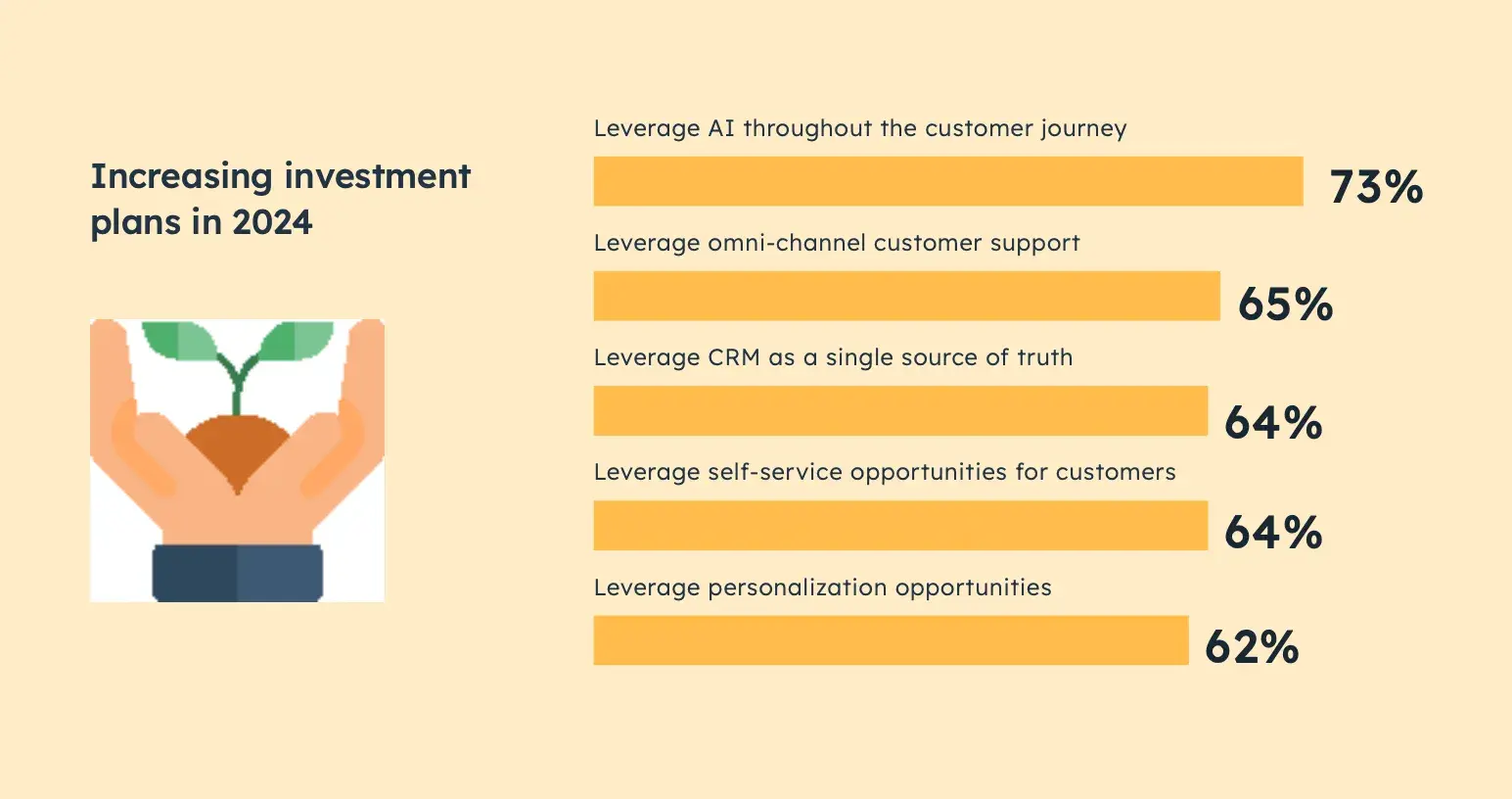
CRM Adoption
Without a CRM, misalignment among teams, tool sprawl, and ineffective software will remain challenges that prevent you from knowing and delighting your customers. That said, investing in a CRM comes with several requirements.
According to our survey, one-third of service reps want their CRM software to track CSAT (31%) and retention (31%), with time spent per interaction and customer LTV closely following in their list of priorities. Not only do these key performance indicators support internal alignment (28%), but they are metrics executives would like to see.
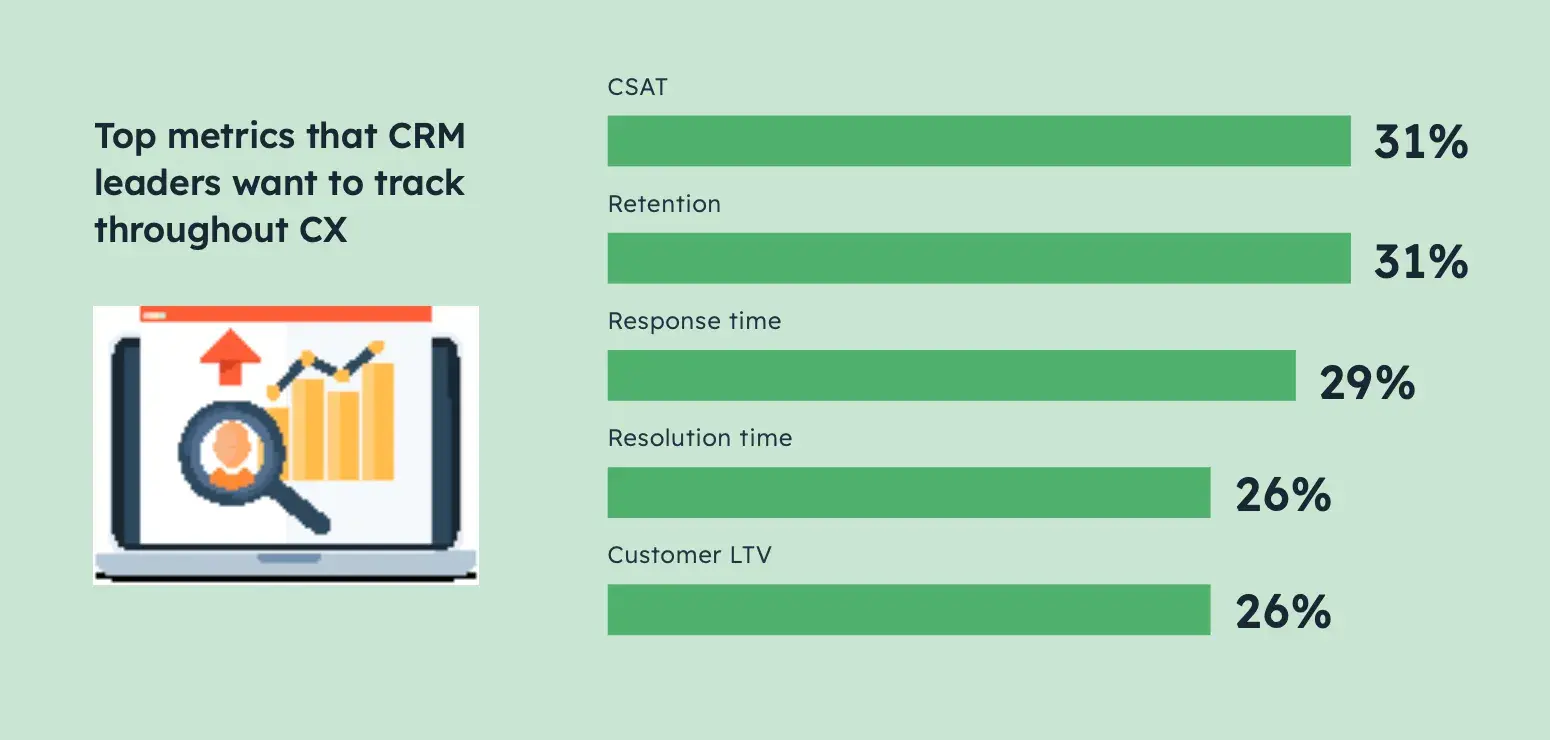
When searching for a CRM, it’s essential to find one that’s robust enough for your company’s needs.
For example, 75% of service leaders using HubSpot say they increased retention in
2023 — a leading KPI for many organizations going into 2024 and beyond. Additionally, 53% of those using HubSpot reduced customer churn and pointed to better personalization, visibility, and collaboration opportunities as levers for preventing churn.
Examples of Companies That Listen to Customers
1. Sunsail

Sunsail provides travel experiences to 20+ breathtaking destinations from the British Virgin Islands and the wider Caribbean to the Mediterranean and the South Pacific. This service requires clients who will pay a premium and also requires exceptional customer service.
According to Stephen Kvedaras, the CRM Product Owner, “The journey to get customers on a yacht safely and seamlessly has the biggest impact on their experience.” The problem? Data silos due to tool sprawling. Kvedaras adds, “You need unified data to run the workflow and provide personalized service.”
As per our study, over three-fourths of customers are expecting a higher level of personalized interactions. That’s why to achieve this and better delight their customers, Sunsail ditched multiple tools like Zendesk and adopted the HubSpot Service Hub, Marketing Hub, and Sales Hub.
2. Apple
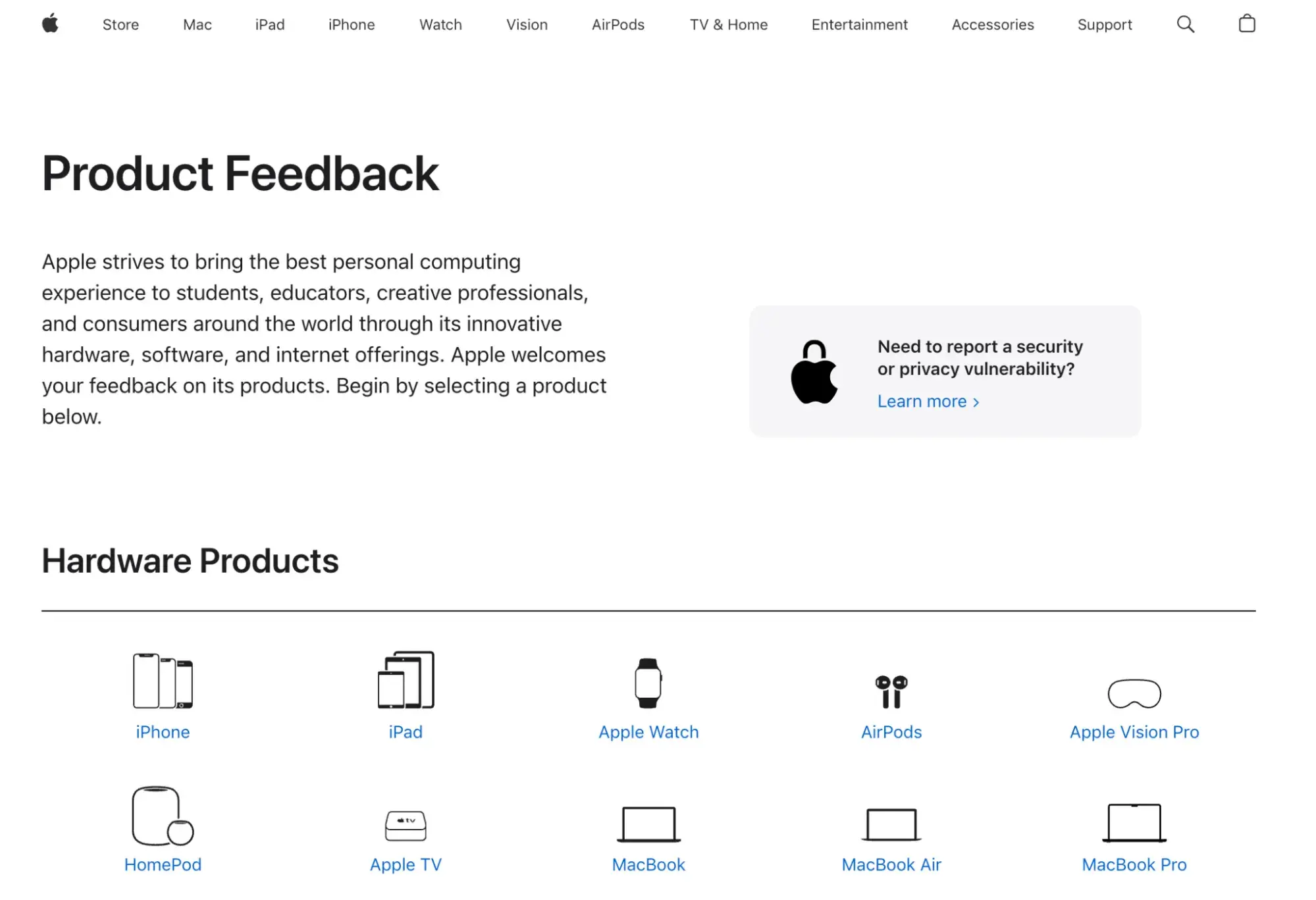
Apple is a global company that takes listening to customers seriously. I found they do this by collecting product feedback, website feedback, and responding to support tickets. They also run Net Promoter Score (NPS) surveys to gather customer feedback that gauges satisfaction and indicates their customers’ likelihood to become Apple advocates.
This approach to customer feedback has been embedded in the company from inception. As Steve Jobs once said, “You’ve got to start with the customer experience and work backwards to the technology.”
3. HubSpot
Listening to customers is an ethos at HubSpot. Like Apple, I like how this has been in the company’s culture since its inception. As Dharmesh Shah, founder and CTO of HubSpot, said: to be customer-first, companies must focus on customers and not competitors.
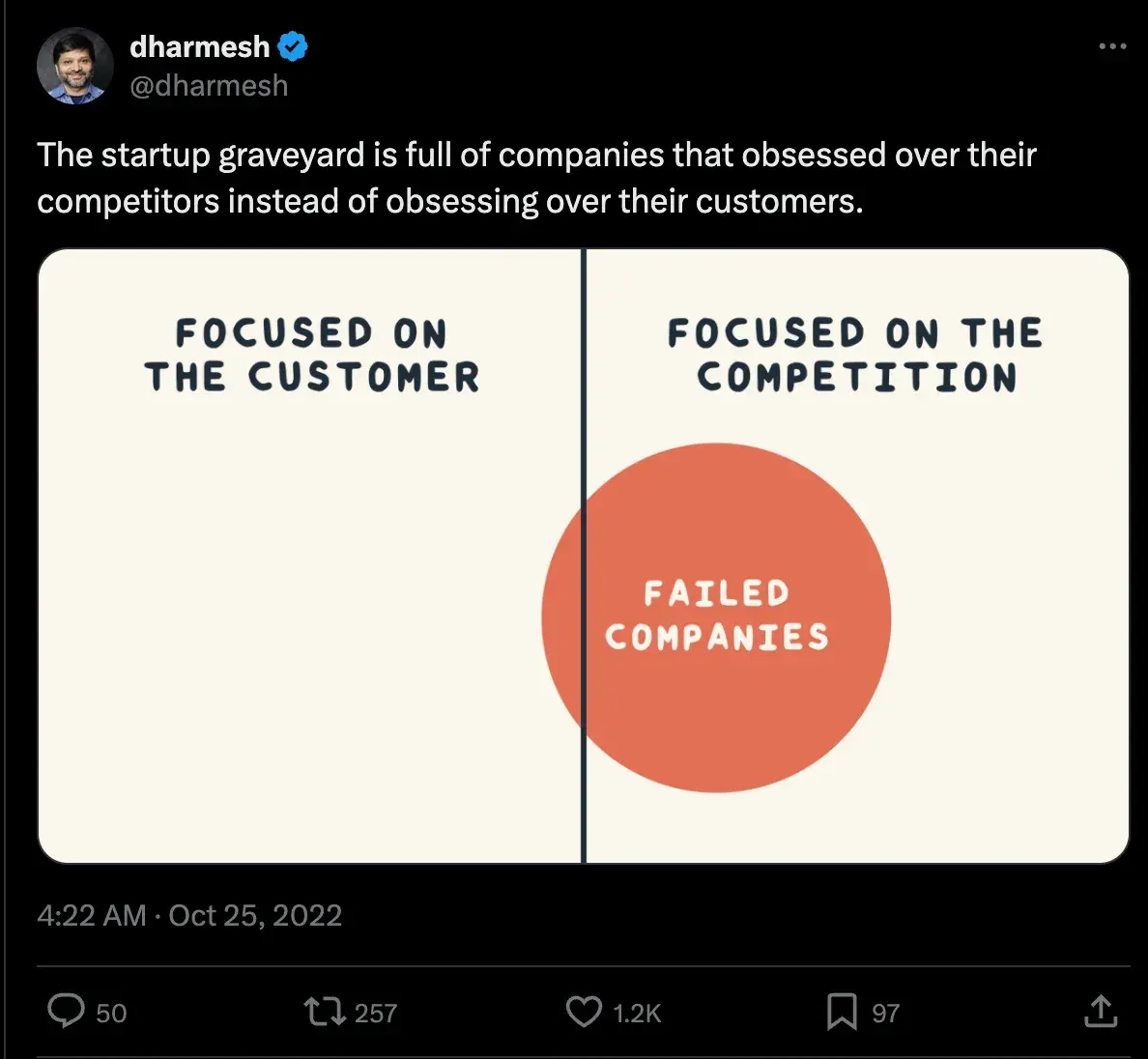
HubSpot prioritizes the customer by listening to them via surveys, customer interviews, and feedback forms integrated into their website.
HubSpot also uses NPS surveys to gauge customer satisfaction and loyalty, as well as in-app prompts to collect feedback on its app features. One treasure trove of feedback that I like is the HubSpot community forum, where HubSpot can easily gather data on top customer issues.
Customers Are the Key to Growth
Most businesses are well-intentioned when they say they are customer-first, but it's time to do more than just say it.
If you want to truly build your business around your customers, try surveying your customers, creating a customer code, and researching how other companies have successfully grown with a customer-first mindset.
Tightening your focus on customers and how they feel about your company/product/service is critical to your growth. Each customer can either become an advocate who drives leads to your business — or a thorn whose damaging reviews can affect your company.
Based on our findings, it's clear that customers expect more, are harder to impress — and their voices are louder. Other service leaders are rising up to the challenge, and so should you. Put your customers first by committing to customer delight.


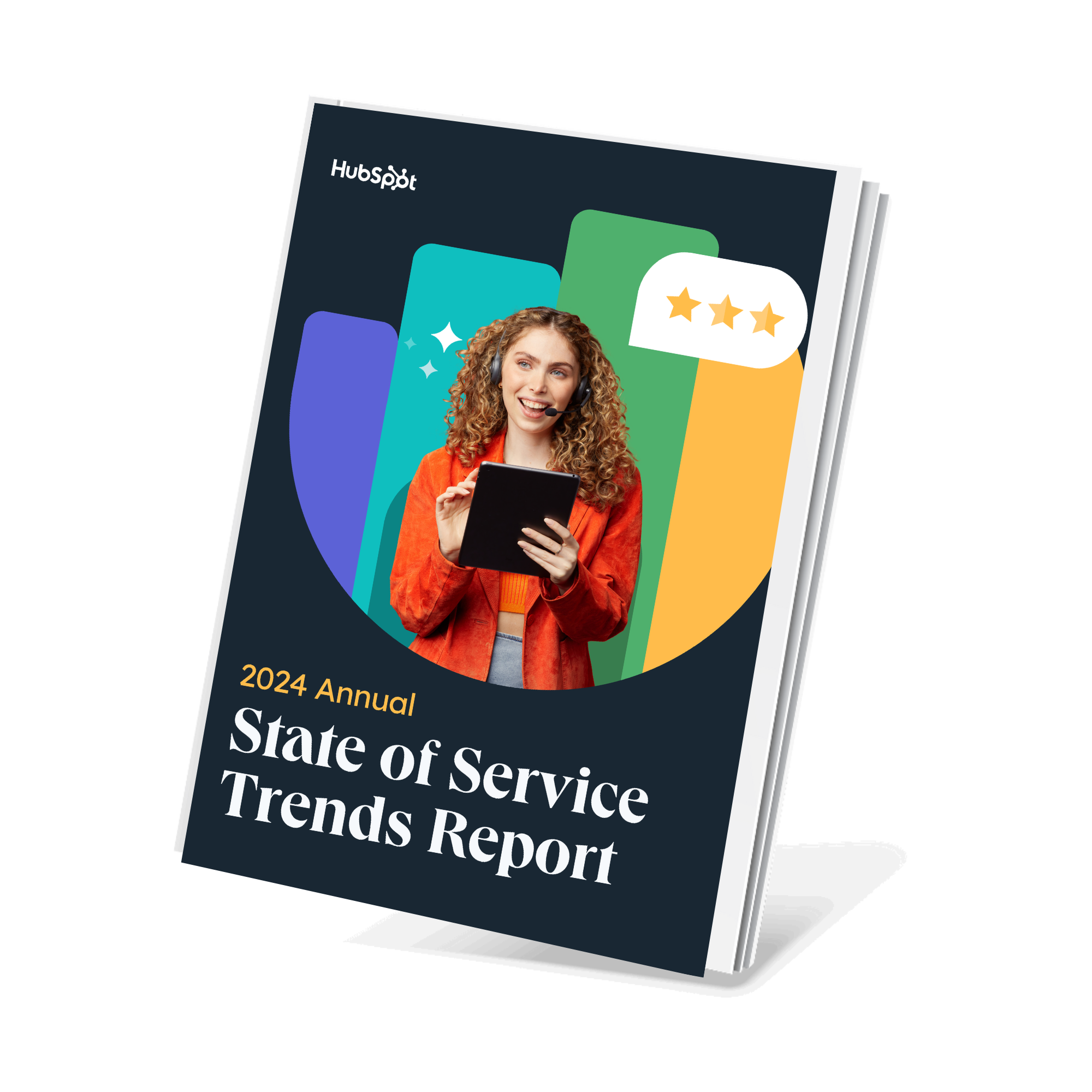

![Why Gen Z Demands Exceptional Customer Support [New Data]](https://53.fs1.hubspotusercontent-na1.net/hubfs/53/Featured%20Image%20Template%20Backgrounds_AC%20Copy.png)


![How COVID-19 Impacted Customer Service & What's Next [Data + Expert Tips]](https://53.fs1.hubspotusercontent-na1.net/hubfs/53/how%20COVID%20impacted%20customer%20service.jpg)
![Why Consumers Get Annoyed With Customer Service Departments [Research]](https://53.fs1.hubspotusercontent-na1.net/hubfs/53/customer-service-annoyances.jpg)
![14 Ways Technology Will Affect the Future of Customer Service [+2024 State of Service Data]](https://53.fs1.hubspotusercontent-na1.net/hubfs/53/change.webp)
![Do Customers More Frequently Use Chat or Phone Support? [HubSpot Data]](https://53.fs1.hubspotusercontent-na1.net/hubfs/53/Google%20Drive%20Integration/Do%20Customers%20More%20Frequently%20Use%20Chat%20or%20Phone%20Support%3F%20%5BHubSpot%20Data%5D-1.png)

